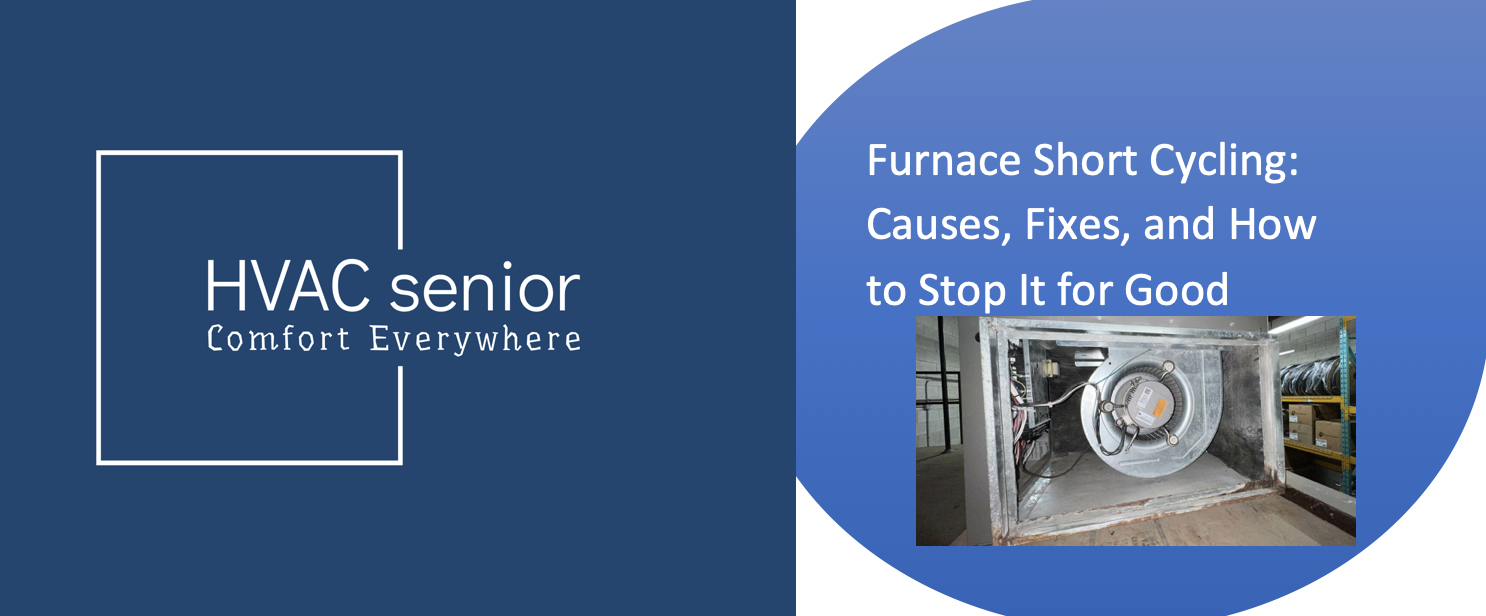If your furnace is constantly turning itself on and then back off, you have something known as short cycling. Not only does this constant stop-and-go pattern make your home uncomfortable, but it also raises your energy bills and places unnecessary strain on your heating system.
In this post, we’ll explain what furnace short cycling is, the most common causes, and step-by-step solutions to fix it-whether you have a gas, electric, or high-efficiency furnace.
What is Furnace Short Cycling?
Furnace short cycling can be defined as when your heating system turns on, runs for a short time-usually less than five minutes-and then turns off before completing a full heating cycle.
A normal, correctly operating furnace will run a cycle anywhere from 10-15 minutes long, depending on your home’s size and insulation. In instances of short cycling, something is impeding airflow, sensors, or the system safety mechanisms of the furnace.
Why Short Cycling Is a Big Problem
Short cycling isn’t just annoying, it’s damaging and expensive.
Here’s what that can lead to:
- Higher energy bills: Constant startups use more power than normal operation.
- UNEVEN HEATING: Your home never reaches the desired temperature.
- Excess wear and tear: Frequent cycling reduces the life of parts like igniters, blowers, and heat exchangers.
- Safety risks: Some causes of short cycling can result in overheating or carbon monoxide buildup.
Also read: Furnace Blower Motor Not Working
Common Causes of Furnace Short Cycling
Let’s look at the top 10 most common reasons your furnace might be short cycling — and what you can do about each one.
1. The air filter is dirty/clogged.
The most common cause of short cycling in furnaces is a dirty air filter. When the filter becomes clogged, it restricts airflow, causing heat to build up inside the system. This increased internal temperature eventually trips the high-limit switch to turn the furnace off to prevent overheating.
Solutions:
- Change your air filter every 30–60 days during heating season.
- Select the proper MERV rating; 8-11 for the average home.
- Keep the vents open and unblocked to allow free airflow.
If the furnace runs longer after replacing the filter, then it was probably the culprit.
2. Blocked or Closed Air Vents
Closed or obstructed vents make it difficult for air to circulate properly, building heat inside the furnace and triggering safety shutdowns; this results in short, repeated cycling.
Solutions:
- Open all supply and return vents in your home.
- Furniture, rugs, or drapes may block the airflow.
- Make sure the vent dampers aren’t stuck closed.
Even unused rooms need to have vents at least halfway open to allow for balanced distribution of air.
3. Faulty Flame Sensor
The flame sensor detects whether your furnace’s burners are lit. If it becomes dirty or corroded, it won’t detect the flame correctly and will shut the gas valve down as a safety precaution, causing your furnace to turn off prematurely.
Solutions:
- Turn power off at the furnace.
- Remove the flame sensor and gently clean it with a fine emery cloth.
- Reinstall it and test the furnace.
If short cycling continues, you may need a replacement sensor.
4. Oversized Furnace
An oversized furnace heats your home too quickly; this causes the thermostat to shut it off before the full heating cycle is complete. This causes constant on-and-off cycling and a general unevenness of temperatures in the rooms.
Fix:
Unfortunately, this issue can’t be solved with simple maintenance.
The only long-term solution is to replace your furnace with one that’s properly sized for your home, based on a Manual J load calculation performed by an HVAC professional.
5. Thermostat Issues
A malfunctioning or improperly located thermostat can provide false readings to the furnace and ultimately make it shut off too early or behave erratically.
Solution:
- Make sure that the thermostat is set to HEAT and “Auto” mode.
- Replace old batteries, if applicable.
- Check placement – avoid placing them near windows, heat vents, or direct sunlight.
- If your thermostat is faulty, consider replacing it with a smart one for better control.
Also read: Why is My Furnace So Loud
6. Overheating Furnace
An overheating furnace automatically shuts off to prevent damage or hazards of fire. This may be caused by a restricted airflow, a dirty blower wheel, or blocked vents. Once it has cooled down, the furnace restarts, therefore causing repetitive short cycling.
Solutions:
- Change or clean filters regularly.
- Schedule a professional cleaning for the blower motor and heat exchanger.
- Keep at least two feet of clearance around your furnace to ensure airflow.
7. Defective Pressure Switch
The pressure switch ensures your furnace’s venting system works correctly by detecting proper airflow through the flue. If it’s defective or clogged, it may shut down the furnace prematurely.
Fix:
- Check vent pipes for blockages such as leaves, bird nests, and debris.
- Check the rubber pressure tube for cracks or disconnection.
- If the switch is faulty, it should be replaced by a technician.
8. Flue or Exhaust Vent Clogging
A blocked exhaust vent prevents combustion gases from escaping safely. Modern furnaces detect this issue and automatically shut off for safety, creating a short-cycling pattern.
Solution:
- Check outdoor flue pipes for ice, snow or animal nests.
- Clear away any obstacles with care.
- Never use a furnace if the vent is blocked; carbon monoxide can build up.
9. Low Gas Pressure or Supply Problems
If the pressure of your gas is too low, the burners won’t stay lit, and the furnace will quickly shut off after ignition.
Solutions:
- Check for supply issues by calling your gas company.
- If only your furnace is affected, the gas valve and burner assembly should be checked by a technician.
- Never attempt gas repairs yourself.
Also read: Flame Sensor Furnace
10. Faulty Control Board or Limit Switch
If all else checks out, it could well be that the furnace control board or the high-limit switch malfunctioned. These components manage your furnace’s safety and cycling logic. A defective one can cause erratic on/off behavior.
Solution:
- A certified HVAC technician can test the components with a multimeter.
- Replace any damaged switches or boards.
How to Diagnose Furnace Short Cycling (Step-by-Step)
Here’s a simple process to help you identify the cause before calling for service:
- Check the air filter – replace if dirty.
- Inspect thermostat settings – Set to HEAT and correct temperature.
- Open all vents – Ensure that airflow is unhampered.
- Check the furnace exhaust – Outdoor blockages should be cleared.
- Listen for burner behavior – Does it shut off too soon? Flame sensor may be dirty.
- Observe the cycle time – Less than 5 minutes per run typically means overheating or airflow problems.
If none of these steps solve the problem, schedule an inspection with a professional who tests electrical and gas components safely.
Professional Repairs and Maintenance
An HVAC technician will do a full diagnostic to identify the exact cause of your furnace short cycling. Common professional services include:
- Cleaning burners and sensors
- Pressure switch and flue system testing
- Temperature rise and airflow measurement
- Checking for Cracked Heat Exchangers
- Verifying proper furnace sizing and duct balance
Ninety percent of short cycling issues can be prevented with annual maintenance.
Also read: Furnace Leaking Water when AC is Off.
How to Avoid Furnace Short Cycling
You can prevent short cycling with a few easy maintenance habits:
- ✅ Replace air filters regularly
- Vents should be kept open and unobstructed.
- ✅ Schedule annual furnace tune-ups
- ✅ Use a programmable thermostat
- Ducts should be checked for leakage or blockages.
- Maintain the area around the furnace clean.
Preventive maintenance stops short cycling, apart from improving efficiency and prolonging the life of furnaces.
When to Replace Your Furnace
If your furnace is more than 15 years old, or you are frequently facing short cycling despite repairs, it may be time for replacement.
Replacement of signs is smarter rather than their repair.
- Repeated part failures
- Rising energy bills
- Uneven heating across rooms
- Noticeable rust or corrosion
A new, energy-efficient furnace (95%+ AFUE) will save money while providing consistent comfort without constant cycling.
Final Thoughts
Furnace short cycling should not be taken lightly. It’s generally indicative of some airflow restrictions, clogged filters, problems with the thermostat, or the safety components shutting down the system. Begin with the general maintenance steps-replace filters, check vents, and clean sensors. If the problem remains persistent, call an HVAC professional to inspect your system. Early intervention in short cycling avoids major damage, saves energy dollars, and allows your home to be constantly warm and safe during the winter.















